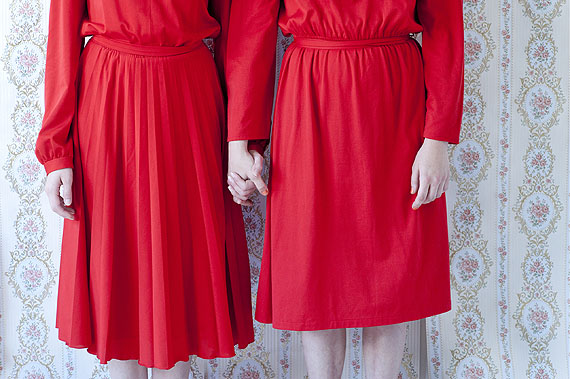
Céline Nieszawer »
Doppelgänger
Exhibition: 8 Nov 2012 – 12 Jan 2013

NextLevel Galerie
8, rue Charlot
75003 Paris
+33(0)1-44 54 90 88
info@nextlevelgalerie.com
www.nextlevelgalerie.com
by appt

Doppelgänger by Céline Nieszawer is now coming to an end at NextLevel gallery. This highly acclaimed photography and video show is the artist’s first solo exhibition at the gallery and runs until Saturday the 12th of January.
Interview by Damien Sausset
Art critic, Director of Centre d’art «Transpalette» in Bourges
English translation by Miranda Salt
Damien Sausset: Series are a recurring theme in your work. What was the driving inspiration behind this one?
Céline Nieszawer: Sometimes, a simple hitch in life can unravel the thread of a long-forgotten, buried, story. In this case, it began with the laborious task of sorting through old family belongings, the kind of cleanup that involved opening lots of dusty cupboards and drawers, boxes and old photo albums. I came across several photos, waiting for me amongst the flotsam. One in particular disturbed me, made me catch my breath. Aged four years old, I am standing quietly beside my older sister, then aged ten. It was our outfits that struck me, as we were dressed identically regardless of our age difference. It was as if a door suddenly opened in my memory to a whole, lost territory. This image, and other, similar ones, was familiar to me but had been suppressed. Looking back, I can see that it was a moment of revelation, a shock. I immediately made the connection with the famous Diane Arbus photo that has haunted me for so long, the Identical Twins (1967) whereby identically dressed twin sisters stare with an intense gaze at the photographer’s lens. The photo from my own family suddenly explained this fascination. Similarly, I now understood why by the ‘evil’ twin sisters from Kubrick’s The Shining, had so transfixed me. It took me some time to work through my own reasons for refusing these memories, as it touched at the very core of the way I had built my own identity. Thinking back, it indeed seems odd to dress two sisters in the same dresses, of the same fabric, as if we were forbidden to express our differences. But in fact our mother, like many of that era, liked sewing and making clothes for us, so cutting two dresses in the same material was simply more practical for her. The clothes were beautifully made, almost as if they were designed to be photographed rather than to be worn. In the images, we appear picture perfect. Or perfectly framed.
DS: You speak of a shock, but what made you decide to do an independent series?
CN: There was no precise decision to start with. I have always observed people in the street who resemble each other and make a point of showing it. So it was a serious photographic exploration (laughs). For it is fascinating even if, from an aesthetic point of view, it can be pretty ordinary. There is a strange, innate power, but in fact, it is about something else. At the beginning, I started photographing little girls, generally sisters. But it didn’t work as the pictures were devoid of the identity ambivalence that I was seeking. It was only afterwards that it became obvious: this strange, unsettled thing I was after, was in fact that of a self cut in two; the self and its other. The sisters thus became a simple extension of this idea and the exhibition title became obvious: Doppelgänger, a German word meaning the evil twin of a living person. Doppelgänger became a kind of open question about the fact that we are often, and ironically, our own, evil twin self.
DS: The idea of the evil twin, this Doppelgänger, is a common theme in Western literature and cinema. How did you go about expressing it photographically? Were you not afraid of falling into the trap of being too illustrative?
CN: No, because I was drawing upon a complex family history, in particular concerning my sister whom I idolized for many years. As in all families, there is love but there is also hate. What mattered was how this shaped me. With this photographic project, I realized that my family history had led me to consider the evil twin as something beyond good and bad: rather than being about a simple inversion, it was the idea that, wherever you positioned yourself, the other was by definition bad. Furthermore I aimed to create a fairly light composition for the pictures.
DS: How did you compose your pictures?
CN: There is always a latent, quite organized, picture slumbering in my unconscious. But it is never the picture I end up making as the process is complicated; on the spur of the moment, I also take into account the models’ suggestions and a thousand other things that spark ideas and lead me to make a different image. In the end, I never regret the final result. It is always the one I was after.
DS: Is that not contradictory?
CN: No, not at all. Take the first picture, for example, of the two young girls dressed in red and holding hands. It is not at all what I originally intended but in fact, it is exactly what I was seeking. I didn’t want the faces to be visible because the project stems from a personal story. Also, each viewer according to his or her own individual ambiguities can interpret an anonymous image. The titles confirm this approach for I chose symbolically weighted names such as Eve, Ange, Grace, Blanche, Marie… We are confronted by a person cut in two, the self and its double, but never identical. It is the self and the mirrored self, contradictory and different. It is harmony and disorder.

DS: How do you set up your images? Do you strictly control poses and expressions, or do you prefer to let the mood establish itself, and then capture it?
CN: First of all, I choose two people. They don’t necessarily resemble each other. The only requirement is that they have similar hair. When they arrive, I set up the props, often wallpaper. As for the clothes, I buy them the day before without worrying about sizes. As soon as they put them on, they are in character. I place them and ask them to strike very precise poses. There is eventually a moment of grace. The photo I wanted is there. There is no rational explanation for it. The photo simply comes to me.
DS: At what moment does one decide to end a series and for what reason?
CN: Today there are 18 pictures. The series is complete, finished.
DS: The desire is no longer there?
CN: No, it’s more complicated than that. Something to do with being balanced in terms of what I originally had in mind. Looking back, I think that 12 pictures would have been enough but, given that it touches on such important, almost essential, things within me, I’m not sure that I’m the best judge of that.
What I hope will be clear is that the ambition for Doppelgänger (beyond my own, personal ‘neuroses’) is that each person will be pushed to think deeply about his or her own identity, and will realize that actually, we are never alone but always in conflict, struggling against this double, this other ‘I’ who inhabits us, damages us but also keeps us alive.
Damien Sausset, Art critic and Director of the Centre d’art «Transpalette» in Bourges
Céline Nieszawer (b. 1965) is currently living and working in Paris.
She began as an assistant to Martine Barrat in New York, on her return to Paris, she became a press photographer. In 1998, she won the SACD prize at Cannes Festival as co-writer of the film À Table by Idit Cebula as part of the Directors’ Fortnight. Following this, she made a number of short films, including Heureuse, produced by Canal +, before embarking on experimental video. Céline Nieszawer also directed a documentary film about the painter Erro, and the making-of of the film La disparue de Deauville by Sophie Marceau. She co-directed Promised Land with Anatole Sternberg, a medium-length film crossing the United States.
Her photographs have been exhibited at numerous galleries and institutions. This is the first solo exhibtion of Céline Nieszawer’s work at NextLevel Gallery.
